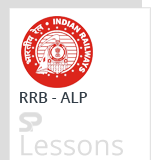RRB ALP and Technicians 2018 - Second Stage CBT Examination Part A, conducted in online Mode, has: a duration of 90 Min, a total of 100 questions and consists of 4 sections, namely - Mathematics, General Intelligence & Reasoning, Basic Science & Engineering and General Awareness on Current affairs. Candidates must clear the cut-off in all the sections to qualify for the Final selection.
 Pattern
Pattern
| S.No | Sections | No. of Questions | Time allocated |
|---|---|---|---|
| 1 | Mathematics | 75 | 60 minutes |
| 2 | General Intelligence and Reasoning | ||
| 3 | Basic Science & Engineering | ||
| 4 | General awareness on current affairs |
 Syllabus
Syllabus
Below mentioned are the different categories of expected questions in the Part A RRB ALP and Technicians General Intelligence & Reasoning section of Second Stage.
| S.No | Topics |
|---|---|
| 1 | Analogies |
| 2 | Alphabetical and Number Series |
| 3 | Coding and Decoding |
| 4 | Mathematical operations |
| 5 | Relationships |
| 6 | Syllogism |
| 7 | Jumbling |
| 8 | Venn Diagram |
| 9 | Data Interpretation and Sufficiency |
| 10 | Conclusions and Decision Making |
| 11 | Similarities and Differences |
| 12 | Analytical reasoning |
| 13 | Classification, Directions |
| 14 | Statement – Arguments |
| 15 | Statement – Assumptions |
Penalty for Wrong Answers (Applicable to both – Preliminary and Main examination):
There will be negative marks for wrong answers in the Objective tests. 1/3rd of mark assigned for question will be deducted for each wrong answer.
 Samples
Samples
1. In a certain code LAWN is written as JCUP. How will SLIT be coded in that code?
- A. QNGV
B. QJGV
C. QNVG
D. NJGV
- A. RISE
B. ROPE
C. ROAD
D. RICE
- A. Nil
B. One
C. Two
D. Three
- A. Four
B. Five
C. Six
D. None of these
- A. criminal : gang
B. display : museum
C. artist : carpenter
D. frame : picture
- A. type : breed
B. dog : puppy
C. mark : spot
D. romaine : lettuce
- A. West
B. South
C. North-East
D. South-West
- A. Only assumption I is implicit
B. Only assumption II is implicit
C. Either I or II is implicit
D. Neither I nor II is implicit
E. Both I and II are implicit
- A. Only assumption I is implicit
B. Only assumption II is implicit
C. Either I or II is implicit
D. Neither I nor II is implicit
E. Both I and II are implicit
- A. 8.5
B. 8
C. 5.25
D. 0
- A. Window
B. Wall
C. Floor
D. Roof
- A. House
B. Cottage
C. School
D. Palace
- A. Kennel
B. House
C. Stable
D. Aviary
- A. C, A, D, B, E
B. C, A, B, D, E
C. C, A, B, E, D
D. C, A, D, E, B
- A. A + C = B + D
B. A + C = 2D
C. A + D = B + C
D. A + C = 2B
- A. 80
B. 25
C. 24
D. 5





